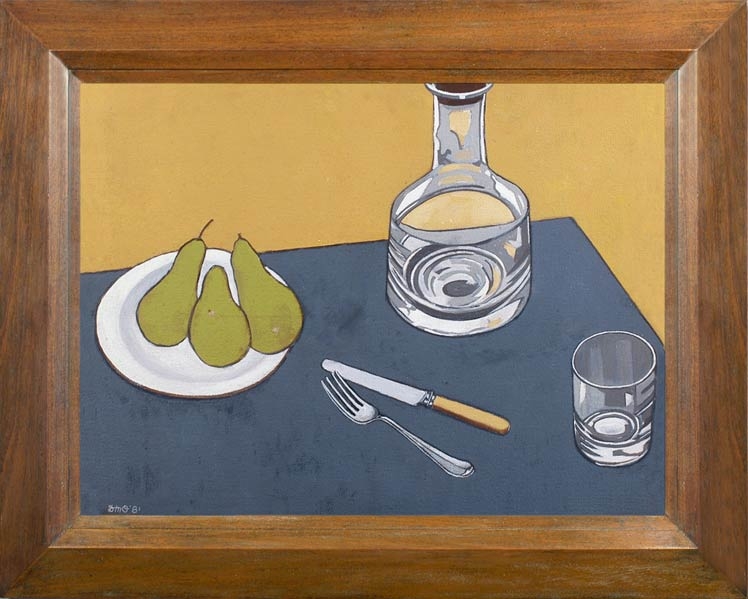A companion to – or variation on – a similar composition of the same year, Still life with a glass jug and an apple. That has a portrait format, however; the present painting has a landscape or horizontal axis. Otherwise, both works have the same simplicity, the same raised viewpoint, and the same small colour range – a dull blue ground, light ochre background and green fruit. This is the radical minimalization of a traditional still life, which marries the pop art approach of a Roy Lichtenstein with the classical refinement of a Chardin. Look how beautifully drawn the knife and fork are, completely in synchrony with the perspective of the plane they inhabit. This is a timeless and serene space, where degradation and decomposition cannot occur.
Biographical details
Sir Duncan Morris Oppenheim was born in St Helen’s, Lancashire, and educated at Repton. He first exhibited his watercolours in the Walker Art Gallery, Liverpool, at the age of 19, but rather than pursue a career in art he entered the family firm of solicitors. He joined British American Tobacco as a solicitor in 1934, and rose to become chairman from 1953-66; he also played a prominent part in the CBI, became a director of Lloyds Bank and chairman of the Tobacco Securities Trust, amongst other posts. During the Second World War he served part-time in the Home Guard in Westminster, whilst continuing to work for British American Tobacco and painting images of civil defence in London.
He continued to paint, becoming a skilful artist in both watercolour and acrylics; he exhibited with the London Group (1954), and in the Royal Academy from 1957-84. In the 1970s he had a one-man show at the Upper Grosvenor Galleries, the catalogue for which had an introduction by Carel Weight, who compared Oppenheim’s work to that of Odilon Redon. Two-thirds of the paintings were subsequently sold. He had further one-man shows at Spink & Sons (1980-83) and New Grafton Gallery (1985 onward).
Oppenheim advised Sir David Eccles, Minister for Works, on the art displayed in ministries and British embassies, and became chairman of the council of the Royal College of Art, receiving an honorary doctorate in 1972. Whilst at the College he encountered both Stanley Spencer and David Hockney, the latter with hair dyed gold and wearing gold lamé to receive a gold medal from Sir Duncan. He also served as chairman of the Council of Industrial Design (1960-72); committee member for the V & A (1967-79); and deputy chairman of the Arts Council (1972-83). In 1960 he was knighted, and in 1969 was awarded the bicentenary medal of the Royal Society of Arts.
Works in public collections include Boredom: air raid wardens on duty, 1940; Finding an unexploded bomb, Barton Street, London SW1, 1940; Searching for casualties…, 1940; The terrible boredom of waiting for action, 1940; The loneliness of an air raid warden on patrol…, 1940-41 (all London, Imperial War Museum).
See obituary, 11 January 2003, Daily Telegraph.


